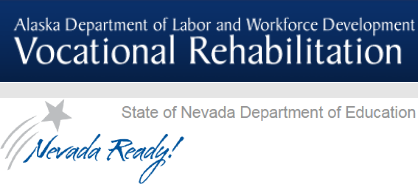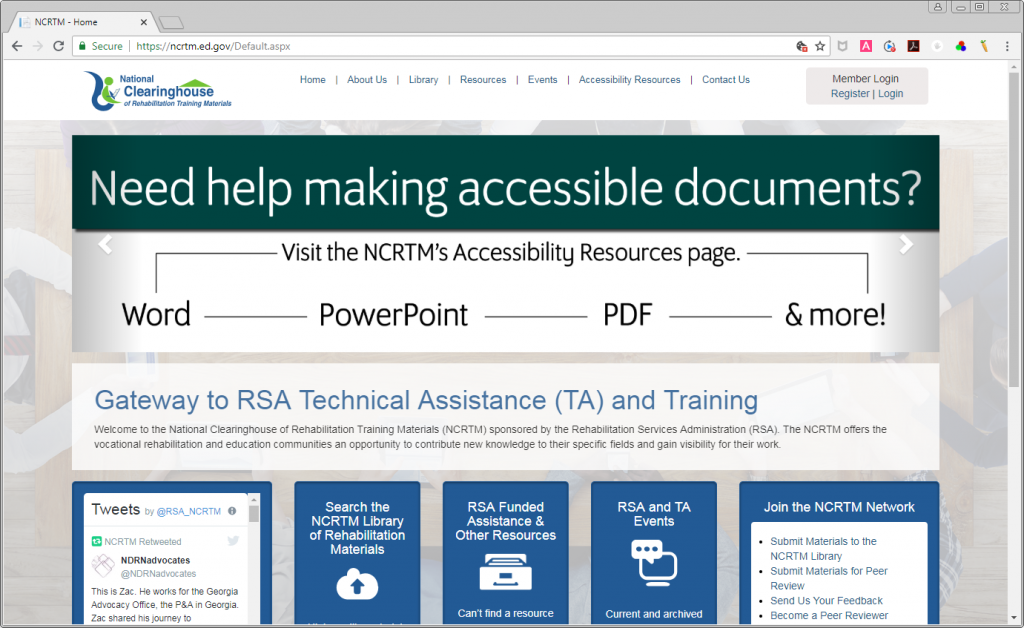The Rehabilitation Act of 1973 (Rehabilitation Act) is landmark legislation, which changed the course of services and expanded the rights of individuals with disabilities in our nation. It set out the purpose, policy and principles that have continued to guide its implementation over the past 50 years.
Category Archives: WIOA
Workforce Innovation and Opportunity Act (WIOA)
Requesting Feedback Related to State VR Agency Technical Assistance Needs
As part of OSERS’ commitment to rethink its work to ensure that it is in the best position to achieve its mission, the Rehabilitation Services Administration (RSA) is rethinking the way it supports and partners with its key stakeholders to improve employment outcomes for individuals with disabilities.
One aspect of this ongoing work is rethinking how RSA evaluates the technical assistance needs of State Vocational Rehabilitation (VR) agencies and RSA’s strategies for disseminating resources and tools that help State VR agencies provide services to individuals with disabilities and the business community.
Through this blog, RSA is interested in receiving feedback from State VR agencies and stakeholders related to two areas: employer services and career advancement under the VR program. In particular, RSA requests that commenters respond to the following questions:
- Do State VR agencies need technical assistance or additional information from RSA related to on-demand training (e.g., online videos) for businesses and other employers related to disability issues?
- If so, what topics should RSA specifically address related to on-demand training for businesses related to disability issues and through what mode(s) should RSA provide this technical assistance to State VR agencies?
- Do State VR agencies need technical assistance or additional information from RSA related to the provision of career advancement services for individuals with disabilities who are employed?
- If so, what topics should RSA specifically address related to career advancement and through what mode(s) should RSA deliver this technical assistance to State VR agencies?
RSA will consider comments submitted to the OSERS Blog through December 5, 2019. We appreciate your thoughtful feedback as we work to maximize employment opportunities for individuals with disabilities.
Note: To help us in our review, we ask that you only address the questions in the comment section. To protect your privacy and the privacy of others, please do not include personally identifiable information, such as a Social Security number, an address, a phone number or an email address in the body of your comment. Comments containing the aforementioned information, or that do not address the above questions, will not be allowed.
Technical Assistance to Improve Postsecondary Transition Services
Use of joint discretionary grant funding from the Office of Special Education Programs (OSEP) and the Rehabilitation Services Administration (RSA) in the Office of Special Education and Rehabilitative Services (OSERS) to provide technical assistance (TA) to State Education Agencies (SEAs), Local Educational Agencies (LEAs), State Vocational Rehabilitation Agencies (SVRAs), and Career and Technical Education (CTE)
U.S. Secretary of Education Betsy DeVos believes in the innate potential of every student and knows that access to high-quality services are an essential part of local, State, and Federal efforts to improve outcomes for all students and youth with disabilities. OSERS is seeking input from the public, particularly SEAs, LEAs, SVRAs, parents and CTE educators, and other relevant stakeholders on how best to provide TA to States in order to improve postsecondary transition services to all students and youth with disabilities. Additionally, OSERS seeks input on how best to strengthen and expand coordination and collaboration with OSERS Parent Training and Information Centers and other relevant TA centers.
Meeting WIOA Requirements: Workforce Innovation Technical Assistance
For National Disability Employment Awareness Month, check out the many resources available in the National Clearinghouse of Rehabilitation Training Materials (NCRTM), funded by the Rehabilitation Services Administration (RSA). Bookmark the NCRTM RSA Technical Assistance & Other Resources page for quick access to the RSA portal, RSA TA centers and funded projects, Workforce Innovation Opportunity Act (WIOA) federal partners, other resources and research databases.
In this final blog of a three-part blog series from NCRTM, we offer ways to stay current with employment trends related to the workforce and people with disabilities. View first blog and second blog from NCRTM.
Successful Work Experiences
NOTE: October is National Disability Employment Awareness Month.
The National Technical Assistance Center on Transition (NTACT) assists state and local education agencies and VR agencies and service providers, and it keeps close contact with these agencies and providers in order to share real stories of real youth being supported in transition programs. Alaska and Nevada are just two of the states that are creating programs to help youth with disabilities transition into a work environment.
The National Clearinghouse of Rehabilitation Training Materials (NCRTM): Finding Promising and Effective Resources in the Clearinghouse Library
For National Disability Employment Awareness Month, check out the many resources available in the National Clearinghouse of Rehabilitation Training Materials (NCRTM), funded by the Rehabilitation Services Administration (RSA).
We offer pointers for finding up-to-date resources in the NCRTM library and showcase a few products from the RSA-funded technical assistance (TA) centers.
The Workforce Innovation and Opportunity Act (WIOA) supports a vision that people with disabilities, including those with the most significant disabilities, can work in competitive and integrated employment.
The NCRTM is one of the first places you should go to find promising and effective practices that have been shared by RSA-funded projects and TA centers so that vocational rehabilitation (VR) personnel, employers, families and individuals with disabilities can improve employment outcomes for people with disabilities.
Call to Action: Make Disability Visible in Everything We Do
This is a cross-post of an Office of Career, Technical, and Adult Education’s Blog post.
Today, July 26, is the anniversary of the signing in 1990 of the Americans with Disabilities Act. In recognition of the spirit of the Act, we are pleased to recommit to the important work of making our programs inclusive and accessible to all.
Disability is part of the human experience, and one of the variables that contribute to the rich diversity of our nation. Disability is not a static condition—people can experience a disability from birth, or develop a disability as a result of genetics, aging, or trauma. Disability does not discriminate—anyone can acquire a disability, at any time. Individuals with disabilities are neighbors, teachers, community leaders, and parents. They are workers, managers, corporate CEOs, and healthcare providers. Individuals with disabilities can and do participate in all realms of work, and their strong participation is vital to our economic growth.
According to the American Community Survey, in 2014, the resident population in the United States was estimated to be approximately 319.9 million individuals; and of this, approximately 31.9 million individuals have some kind of disability, including both apparent and non-apparent disabilities. Yet individuals with disabilities still face barriers to full, family-sustaining employment.
On June 21, 2016, the Bureau of Labor Statistics released the Persons with a Disability: Labor Force Characteristics. The data on persons with a disability are collected as part of the Current Population Survey (CPS), a monthly sample survey of about 60,000 households that provides statistics on employment and unemployment in the United States. Based on this report, in 2015, 17.5 percent of persons with a disability were employed. The unemployment rate for persons with a disability was 10.7 percent in 2015, compared to 5.1 percent for those without a disability. Some key findings (and where to find them in the report) include:
- Among all educational attainment groups, unemployment rates were higher for persons with a disability than for those without a disability.[1] (Table 1)
- Persons with a disability are less likely to have completed a bachelor’s degree or higher than those with no disability. (Table 1)
- Across all levels of education, persons with a disability were much less likely to be employed than were their counterparts without a disability. (Table 1)
- Thirty-two percent of workers with a disability were employed part-time, compared with 18 percent for those without a disability. (Table 2)
- Persons with a disability were more heavily concentrated in service occupations than those without a disability (21.7 percent compared with 17.2 percent) and less likely to work in management, professional, and related occupations than those without a disability (31.3 percent compared with 39.2 percent). (Table 3)
- The jobless rate was higher for minorities with a disability (17.4 percent for Blacks and 13.3 percent for Hispanics) than among Whites (9.6 percent) and Asians (7.4 percent). (Table 1)
Inclusion of individuals with disabilities cannot be an afterthought. We—the Employment and Training Administration (ETA) and Office of Disability Employment Policy (ODEP) at the U.S Department of Labor (DOL), the Office of Special Education and Rehabilitative Services (OSERS)/the Rehabilitation Services Administration (RSA), and the Office of Career, Technical and Adult Education (OCTAE) at the U.S. Department of Education (ED) and our grantees—will continue to consider the experiences of individuals with disabilities, be intentional about including disability in our policy and program documents, incorporate universal design in our service delivery strategies, and continue to be inclusive in our use of language. Moreover, we will continue to ensure that youth and adults with disabilities can access our education, training, and workforce programs and successfully complete them. We will work closely with America’s employers and our local partners in the workforce development system to ensure physical, programmatic, and employment access across the board. Finally, we must continue to actively foster a culture in which individuals are supported and accepted for who they are, without fear of discrimination based on disability.
In full support of this call to action, we will make improvements to the programs we are responsible for administering in the Workforce Innovation and Opportunity Act (WIOA), the Carl D. Perkins Career and Technical Education Act, and complementary programs that affect the opportunities of individuals with disabilities. We will strengthen alignment and find new ways to provide better services to more people through close collaboration at the national, state, local, and tribal levels among our respective programs.
Significant work is already under way. OSERS/RSA, and OCTAE will soon release technical assistance resources focused on expanding access and support for individuals with disabilities in education programs under WIOA—especially through career pathways, a model endorsed by 12 federal agencies. DOL’s ODEP, ETA, and Civil Rights Center have issued a set of best practices for physical and programmatic accessibility for individuals with disabilities. Collectively, we are gathering concrete examples of promising practices, partnerships, and interventions offered by core and partner programs under WIOA. We are seeking examples of innovations focused on changing the prospects of youth and adults with disabilities, for possible inclusion in the resources. If you are aware of such efforts, please tell us about them either by emailing us at inclusion@ed.gov. In particular, we are interested in your answers to the following questions:
- How are the WIOA core and partner programs in your community creating a welcoming environment for people with visible and hidden disabilities?
- How are the WIOA core and partner programs in your community ensuring that American Job Centers and career workforce education and training services are accessible to individuals with disabilities?
- How are the WIOA core and partner programs in your community using data to effectively identify individuals with disabilities, determine customized interventions, and monitor the effectiveness of your supports?
- How are the WIOA core and partner programs using multiple funding sources to assure that individuals with disabilities have the services and supports needed to succeed?
- Can you share examples of promising career pathways programs that are improving outcomes for individuals with disabilities?
We are always looking for innovative ways to expand opportunities for individuals with disabilities through demonstration grants. Here are two key examples:
- ED has recently initiated a five-year, $3.5 million per year Career Pathways for Individuals with Disabilities (CPID) model demonstration program in Georgia, Kentucky, Nebraska, and Virginia. The purpose of the program is to demonstrate replicable promising practices in the use of career pathways: to enable VR-eligible individuals with disabilities, including youth with disabilities; to acquire marketable skills and recognized postsecondary credentials; and, to secure competitive integrated employment in high-demand, high-quality occupations. Program activities are being designed and implemented in partnership with secondary and postsecondary educational institutions, American Job Centers, workforce training providers, social and human service organizations, employers, and other Federal career pathways initiatives.
- The DOL’s Disability Employment Initiative (DEI) expands the capacity of the workforce system to improve the education, training, and employment outcomes of youth and adults with disabilities, and uses a career pathway framework to increase opportunities. DEI is funded jointly by ETA and ODEP; these agencies published a new Funding Opportunity Announcement (FOA) for a seventh round of these grants for state workforce agencies on June 27, 2016. The FOA can be found at grants.gov and it closes August 1, 2016. We encourage states to apply. The newest grantees will be announced in the coming weeks.
As a nation, we must continue to promote inclusion and to break down the barriers that remain—in hearts, in minds, in habits, and in policies—to the security and prosperity that stable jobs provide and that all people deserve. Thank you for your partnership in this important work.
- Johan E. Uvin is the Deputy Assistant Secretary, delegated the duties of the Assistant Secretary, for the Office of Career, Technical, and Adult Education.
- Sue Swenson is the Acting Assistant Secretary for the Office of Special Education and Rehabilitative Services.
- Janet L. LaBreck is the Commissioner for the Rehabilitation Services Administration.
- Portia Wu is the Assistant Secretary for the Employment Training Administration at the U.S. Department of Labor.
- Gerri Fiala is the Deputy Assistant Secretary for the Employment Training Administration at the U.S. Department of Labor.
- Jennifer Sheehy is the Deputy Assistant Secretary for the Office of Disability Employment Policy at the U.S. Department of Labor.
[1] Educational attainment data are presented for those age 25 and over.
5 Things You Should Know about WIOA
This is a repost of a Blog on ED’s Homeroom.
Friday marked the two-year anniversary of President Obama signing into law the Workforce Innovation and Opportunity Act (or WIOA for short). Last month, the Departments of Labor and Education, in close collaboration with the Departments of Health and Human Services, Agriculture, and Housing and Urban Development, made publicly available the final rules implementing WIOA. We are excited to continue the conversation around WIOA and we are committed to making sure WIOA works for all job-seekers, workers, and employers as the departments implement the final rules.
Here’s what WIOA means and why it matters.
The WIOA final rules, along with accompanying resources, are available at the following links:
Janet Terry: A Workforce Development Success Story
Janet Terry, winner of the Pennsylvania Governor’s Achievement Award for the Outstanding Senior Community Service Employment Program Participant.
Steps to Success
In 2012, when Janet Terry stepped into the PA CareerLink, an American Job Center, in Pittsburgh, Penn., she brought with her an extensive criminal background and a history of substance abuse dating back to when she was just 16. Through the American Job Center, Janet connected with the Pennsylvania Office of Vocational Rehabilitation (OVR), where her vocational rehabilitation counselor assisted Janet with enrolling in the Community College of Allegheny County’s Modern Office Systems Training (MOST) program. Before Janet could begin administrative assistant training with MOST, she needed extensive computer training, which she received through the Allegheny County Senior Training and Employment Program (STEP). Janet graduated from STEP six months later certified at 50 words per minute with 98 percent accuracy. Janet also participated in the STEP Monthly Job Club, where she learned successful job search skills, along with how to write an effective resume and cover letter. As a result of the knowledge and skills gained from STEP and MOST, Allegheny County hired Janet in 2015 as an administrative assistant earning $10/hour with health benefits.
Because of her successful reintegration into society, Janet no longer reports weekly to her parole officer and she is in the process of seeking a governor’s pardon. Janet works full-time and recently received a promotion with a raise! Of all her accomplishments, she most values the respect and trust she has earned from her family, friends, and peers. Janet’s success did not go unnoticed by the Pennsylvania Department of Aging, which presented her with the Governor’s Achievement Award for Outstanding Senior Community Service Employment Program participant! The U.S. departments of Education (ED) and Labor (DOL), in partnership with Health and Human Services (HHS), have recently announced that the final rules of the Workforce Innovation and Opportunity Act (WIOA) are now available.
ED, DOL, and HHS Support
Workers and job seekers, like Janet, can seamlessly access a system of high-quality career services, education, and training through the one-stop service delivery system, known as the American Job Centers, and its partners. Janet’s success through the American Job Center was supported in part by programs in:
- ED’s Office of Special Education and Rehabilitative Services’ (OSERS) Rehabilitation Services Administration (RSA)
- ED’s Office of Career, Technical, and Adult Education (OCTAE)
- DOL’s Employment and Training Administration (ETA)
- HHS’ Administration for Children and Families (ACF)
More about WIOA
WIOA, signed by President Obama on July 22, 2014, is the first major reform to federal job training programs in more than 15 years. WIOA is designed to improve the coordination of employment and training services across federal agencies, strengthen collaboration with state and local partners, and provide Americans with increased access to training, education, and other support to succeed in the job market and in their careers. WIOA is aimed at increasing opportunities, particularly for those facing barriers to employment including individuals with disabilities, and invests in the important connection between education and career preparation.
ED and DOL, in partnership with HHS, have collectively issued five rules to implement WIOA and resources such as fact sheets and reference guides. For more information, please visit the following WIOA homepages: RSA, OCTAE, and ETA.
5 Million Reasons to Care About Youth Not in Education or Jobs
This is a cross post from an
Office of Career, Technical, and Adult Education Blog post
The Office of Career, Technical, and Adult Education (OCTAE) has been shining a spotlight on the challenges faced by disconnected youth and the programming models focused on their challenges for the past several years. These are youth roughly 16 to 24 years of age, who are not engaged in education and not employed. They may be living at home or be homeless. They may be in or may have emancipated from the foster care system. They may be high school non-completers or those who have completed some college courses or received credentials. They may live in urban, rural or suburban communities. They may be in or released from justice-involved facilities. They may be single, married, and/or parents.
With this post, OCTAE kicks off a blog series examining what we know about disconnected youth, promising programming models, and the data used to track progress in reconnecting youth with education, training, employment, community, and their families.
We use the term “disconnected” youth, as this is the term used in the statutes and authorities that allow OCTAE to support disconnected youth. These “disconnected” youth have also been called “opportunity” youth.
Youth Not in Education, Employment or Training (NEET)
If you are like me, you like good news more than bad news. That is why many of us in the youth development and education fields were ecstatic to learn that there are almost 300,000 fewer youth who are disconnected than there were in 2010. That is great news.
Not such great news is that these gains vary a lot—and we would argue, too much—depending on where youth live and their race, gender, ethnicity, and home language. Of equal concern is that there are still more than 5 million disconnected youth in our country.
The new data from the Survey of Adult Skills can inform us about youth in the United States who are Not in Employment, Education, or Training, or NEET youth, as the OECD calls these youth.[1]
The U.S. National Supplement of the Survey of Adult Skills, released on March 10, 2016, reported on an enhanced sample in the U.S. that oversampled the unemployed, young adults (ages 16-34), and older adults (ages 66-74).[2] These data allow us to examine the education and work status of youth, their educational and family backgrounds, skill use at work and in everyday life, and proficiency of directly-assessed foundation skills (literacy, numeracy, and digital problem solving).
As the Survey of Adult Skills data have shown, in the U.S. economy, skills matter – almost as much as a credential. The question then becomes: what skills do NEET youth possess? Do they have the foundation skills they need to re-connect and get ahead?
The U.S. National Supplement found that nearly 5% of 16-24 year olds were in NEET status, that is, not engaged in employment, education or training in the 12 months before responding to the Survey. Many of these NEET youth have very low skills. A quarter of NEET youth perform below Level 2 in literacy, and 45% perform as low in numeracy.
The literacy and numeracy domains of the Survey are reported in five levels; skills below Level 2 are considered “low-skilled” according to the OECD, which means that one’s skills are so basic they may prevent an individual from advancing or being able to take advantage of training opportunities that could lead to advancement.[3]
By contrast, youth (age 16-24) who are engaged in education and/or employment tend to score higher in both domains. Less than 16% of youth who are enrolled in formal education and/or are employed score below Level 2 in literacy, and less than 33% score below Level 2 in numeracy.
We need to better understand who the NEET youth are so that we can provide them with opportunities to raise their skills.
These findings trigger many additional critical questions. How many youth, for instance, are young parents? How many are English language learners? How many have a disability? How many are poor or low income? How many are living on their own? Many more analyses can and must be done. Fortunately, the data are here (note: the U.S. National Supplement data is to be released summer 2016) that facilitate further learning.
I think we are at an important point in time. We know that some of our work is paying off. Having nearly 300,000 fewer disconnected youth in six years is no small feat. We also need to acknowledge, though, that what we are doing is almost like tinkering around the edges. We need a strategy that works for over 5 million youth. We need to supplement what we do with a strategy that is at scale by design. That strategy must have a prevention component to it, as well as components that re-connect youth and involve them as leaders in the effort.
Watch for future posts that will spotlight more data and positive programming models.
[1] See the OECD report on NEET youth at https://data.oecd.org/youthinac/youth-not-in-education-or-employment-neet.htm.
[2] The enhanced sample will also include individuals who were incarcerated. Findings from those data will be released later in 2016. Data from incarcerated individuals are not included in the data cited here.
[3] (OECD, 2013). Time for the U.S. to Reskill? What the Survey of Adult Skills Says.








